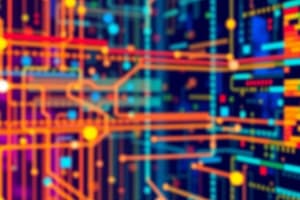Podcast
Questions and Answers
What term describes a single set of hardware, software, databases, telecommunications, people, and procedures?
What term describes a single set of hardware, software, databases, telecommunications, people, and procedures?
- Information System
- CBIS (correct)
- Data Management
- Business Process
Which role is responsible for defining and prioritizing requirements within a project?
Which role is responsible for defining and prioritizing requirements within a project?
- Back-end Developer
- Game Developer
- Business Analyst (correct)
- Database Administrator
What is the primary focus of Business Process Reengineering (BPR)?
What is the primary focus of Business Process Reengineering (BPR)?
- Enhancing user experience
- Implementing new technology
- Radical redesign of business processes (correct)
- Improving database performance
Which of the following best defines 'data'?
Which of the following best defines 'data'?
What is the key purpose of feedback in information systems?
What is the key purpose of feedback in information systems?
What does efficiency in an information system aim to optimize?
What does efficiency in an information system aim to optimize?
Which type of network covers a larger area than a LAN but smaller than a WAN?
Which type of network covers a larger area than a LAN but smaller than a WAN?
What is meant by timely information in the context of information systems?
What is meant by timely information in the context of information systems?
What is the term for a structured and standardized process for all system development activities?
What is the term for a structured and standardized process for all system development activities?
Which methodology proceeds sequentially from one phase to the next?
Which methodology proceeds sequentially from one phase to the next?
What is the primary focus of Agile methodology?
What is the primary focus of Agile methodology?
What is the term for a smaller version of a system with minimal features?
What is the term for a smaller version of a system with minimal features?
What key activity occurs during the system analysis phase?
What key activity occurs during the system analysis phase?
Which conversion method is suggested as suitable when the new system must be activated immediately?
Which conversion method is suggested as suitable when the new system must be activated immediately?
What is the purpose of System Requirements Specifications (SRS)?
What is the purpose of System Requirements Specifications (SRS)?
What phase is characterized by a feasibility study being conducted?
What phase is characterized by a feasibility study being conducted?
Which term describes the temporary and volatile memory in a computer system?
Which term describes the temporary and volatile memory in a computer system?
What is the term for simultaneous execution of two or more instructions?
What is the term for simultaneous execution of two or more instructions?
What does the kernel of an operating system do?
What does the kernel of an operating system do?
What is the process called when old and new systems operate simultaneously until user satisfaction is reached?
What is the process called when old and new systems operate simultaneously until user satisfaction is reached?
Which of the following best describes the SDLC phase of system analysis?
Which of the following best describes the SDLC phase of system analysis?
What does multitasking OS allow users to do?
What does multitasking OS allow users to do?
What does system testing focus on?
What does system testing focus on?
What is the main goal of agile methodology in the SDLC?
What is the main goal of agile methodology in the SDLC?
What commonly describes legitimate-looking emails that deceive users into revealing personal information?
What commonly describes legitimate-looking emails that deceive users into revealing personal information?
Which of the following is likely to be a result of increased complexity in computing environments?
Which of the following is likely to be a result of increased complexity in computing environments?
What is the primary function of worms in a computer system?
What is the primary function of worms in a computer system?
What term is used for a field in a database that must be unique for each entity?
What term is used for a field in a database that must be unique for each entity?
Which software package is considered the main support for database management approaches?
Which software package is considered the main support for database management approaches?
Which of the following defines the structure of database content and is used to create tables?
Which of the following defines the structure of database content and is used to create tables?
What tool is primarily used for analyzing data to find patterns in historical business activities?
What tool is primarily used for analyzing data to find patterns in historical business activities?
Which statement is true regarding the role of a Database Administrator (DBA)?
Which statement is true regarding the role of a Database Administrator (DBA)?
Flashcards
Information
Information
Facts organized and processed for a specific purpose, giving them value beyond the individual facts.
Effectiveness
Effectiveness
The ability to achieve the intended goal, focusing on doing the right tasks correctly.
Feedback
Feedback
Information used to adjust inputs and processes within a system for improvement.
CBIS
CBIS
Signup and view all the flashcards
Database
Database
Signup and view all the flashcards
Processing
Processing
Signup and view all the flashcards
Knowledge
Knowledge
Signup and view all the flashcards
Business Process Reengineering (BPR)
Business Process Reengineering (BPR)
Signup and view all the flashcards
Kernel
Kernel
Signup and view all the flashcards
System Utilities
System Utilities
Signup and view all the flashcards
Multitasking OS
Multitasking OS
Signup and view all the flashcards
Scalability
Scalability
Signup and view all the flashcards
Memory Management
Memory Management
Signup and view all the flashcards
System Analysis
System Analysis
Signup and view all the flashcards
Black Box Testing
Black Box Testing
Signup and view all the flashcards
Implementation/Programming
Implementation/Programming
Signup and view all the flashcards
Non-operational Prototype
Non-operational Prototype
Signup and view all the flashcards
System Development Life Cycle (SDLC)
System Development Life Cycle (SDLC)
Signup and view all the flashcards
System Requirements Specifications (SRS)
System Requirements Specifications (SRS)
Signup and view all the flashcards
Agile Development
Agile Development
Signup and view all the flashcards
Direct Conversion
Direct Conversion
Signup and view all the flashcards
System Design
System Design
Signup and view all the flashcards
System Maintenance
System Maintenance
Signup and view all the flashcards
Crackers
Crackers
Signup and view all the flashcards
Trojan Horse
Trojan Horse
Signup and view all the flashcards
Zombie Network
Zombie Network
Signup and view all the flashcards
DDoS Attack
DDoS Attack
Signup and view all the flashcards
Software Vulnerability
Software Vulnerability
Signup and view all the flashcards
Relational Database
Relational Database
Signup and view all the flashcards
Primary Key
Primary Key
Signup and view all the flashcards
Database Management System (DBMS)
Database Management System (DBMS)
Signup and view all the flashcards
Study Notes
In-Class Revision "Sample Questions"
- Information: Collection of facts organized and processed to have value beyond individual facts.
- Effectiveness: Doing the objective correctly.
- Feedback: Information from the system used to change input or processing activities.
- CBIS: Single set of hardware, software, databases, telecommunications, people, and procedures.
- Database: Organized collection of facts and information (typically two or more related data files).
- Business Analyst: Defines and prioritizes requirements, and gets feedback and approval on them.
- Game Developer: Contributes to audio and animation design.
- Database Administrator: Creates and maintains database standards and policies.
- Cybersecurity Consultant: Identifies security threats and determines best security measures.
- Back-end Developer: Responsible for creating and maintaining website components unseen by users.
- Processing: Converting data into useful outputs.
- Knowledge: Awareness and understanding of a set of information.
Lecture #1 & #2
- System Unit: Houses CPU and memory.
- RAM: Temporary and volatile memory.
- Traditional/Serial Processor: A single processor executes program instructions step-by-step.
- Multiprocessing: Simultaneous execution of two or more instructions.
- Backup: Copy of programs, data, and information created on one secondary storage medium, duplicated to another.
- Kernel: Central part of OS with complete control.
- System Utilities: Software programs essential for effective computer system management (backup, antivirus).
- Multitasking OS: Permits more than one application to run simultaneously.
- Scalability: Ability to handle increasing numbers of concurrent users smoothly.
- Memory Management: Controls memory access and maximizes available memory and storage.
Lecture #3
- Output Devices: Monitors, printers, speakers, and plotters.
- Input Devices: Point-of-sale (POS) and Automatic Teller Machine (ATM) devices.
- RAM Memory: Temporary and volatile.
- Multiprocessing: Simultaneous execution of two or more instructions.
- Direct Access: Retrieving records in any order.
- Operating System: Coordinates hardware and program activities.
- ROM Memory: Nonvolatile.
- Graphical User Interface (GUI): Uses icons and menus for sending commands.
Lecture #4
- System Analysis: Identifying problems and their causes.
- System Testing: Testing system functionality as a whole.
- Parallel Conversion: Running old and new systems simultaneously until users are satisfied.
- Black Box Testing: Testing without knowledge of the code.
- Implementation/Programming: Translating design specifications into software code.
- Agile: Streamlines SDLC by reducing modeling and documentation overhead.
- Outsourcing: Eliminates staffing problems.
- Non-operational Prototype: Mockup/model with output, input specifications and formats.
- SDLC/System Development Life Cycle: Structured/standardized process for system development.
- SRS/System Requirements Specification: Describes system specifications that deliver needed functions.
- RAD/Rapid Application Development: Rapid application development through iterative prototyping.
Lecture #5
- Direct Conversion: Only viable conversion solution when activating a new system is urgent or systems can't coexist.
- System Analysis: Feasibility study phase.
- System Maintenance: Post-implementation audit documents.
- System Conversion: Process of changing from an old system to a new one.
- RAD/Rapid Application Development: Iterative prototyping for rapid application development.
- Waterfall Methodology: Sequential methodology where the team proceeds from one phase to the next.
- System Analysis: Identifying problems and their causes.
- Data Mining: Tools for analyzing data to discover hidden patterns and trends.
- Data Definition Language (DDL): Defines database structure, tables, and field characteristics.
- Data Manipulation Language (DML): Used to insert, update, delete, and retrieve data from a database.
- Phishing: Legitimate-looking emails leading users to fake websites to get personal information.
- Zombies (in DDoS attacks): Computers taken over in a DDoS attack.
- Crackers: Hacking with criminal intent to steal or damage data.
- Spam: Low-cost commercial advertising for questionable products
Lecture #6
- Database Administrator (DBA or Database Admin.): Specialist in charge of organization's databases.
- Database Schema: List of all tables in the database, including primary and foreign keys.
- Primary Key: Unique field defining each entity.
- DBMS (Database Management System): Main software package for database management.
- Data Warehouse: Collects business information from various sources covering company processes, products, and customers.
- DBMS (Database Management System): Group of programs acting as an interface between the database and user/application programs.
Lecture #7
- Data mining: Tools to analyze historical business activity data, revealing hidden trends and patterns.
- Data Definition Language (DDL): Defines the structure of a database.
- Data Manipulation Language (DML): Used to modify database data (insert, update, delete).
- Relational Database: Organizes data in related tables.
True or False Statements
- Phishing: Low-cost marketing method also used by legitimate organizations (False).
- User Responsibility for Trojans: Users are responsible for installing trojans to eliminate vulnerabilities (False).
- Increased Computing Complexity: Increased computing environment complexity increases vulnerability to security incidents (True).
- Worms: Reside in active computer memory and duplicate themselves.
- Viruses: Attach to files, execute when opened.
- Trojan: Malicious code disguised in harmless programs.
Studying That Suits You
Use AI to generate personalized quizzes and flashcards to suit your learning preferences.




